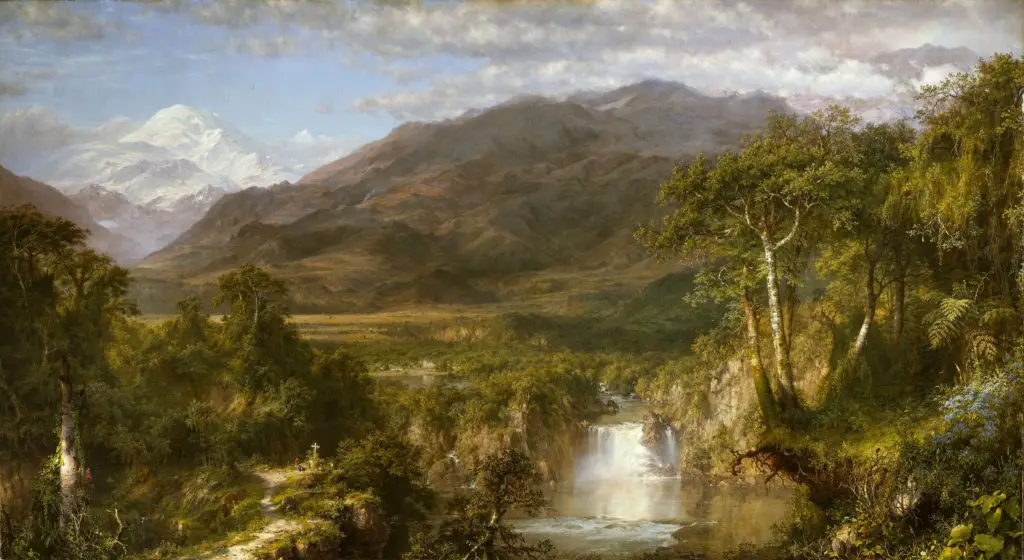The Journey of ‘Heart of the Andes’: An Artistic Exploration

In a journey to discover the storied history of a masterpiece, we find ourselves captivated by the tale of Frederic Edwin Church’s ‘Heart of the Andes’. We voyage back to the creation process, delving into the narrative of the passionate artist behind the work, discerning Church’s artistic motivations, inspirations, and methods that breathed life into this glorious canvas. As we embark on this exploration, sense the anticipation in New York as it readied itself for the premiere of ‘Heart of the Andes’, experiencing in recollection the awe and wonder of the spectators and the critical acclaim it received.
Creation of Heart of the Andes
The Enthralling Genesis of ‘Heart of the Andes’
Behind the creation of many great masterpieces lies a captivating saga, a unique blend of inspiration, dedication, and transformation. Such is the tale of one of the most highly celebrated gems of the art world: the ‘Heart of the Andes’ by Frederic Edwin Church. Born from a remarkable fusion of real-world exploration and unbridled imagination, this work of art beams with the essence of nature’s grandeur.
Born in 1826, Church was a central figure of the Hudson River School – an American art movement known for romantic landscapes evoking transcendental experiences. Yet it was during his exploration of South America that Church’s artistic journey found its zenith, culminating in the ‘Heart of the Andes’.
When one’s gaze falls on the ‘Heart of the Andes’, there’s an immediate sense of sitting in the heart of a lush, undisturbed jungle; it’s a scene one could almost step into, such is the finesse of detail. Yet, this exquisite panorama is not a snapshot of any single place, despite the artist’s rich interaction with South American nature. Instead, this artwork is a magnificent medley of the artist’s experiences, an awe-inspiring fusion of various landscapes witnessed during that journey.
Church’s time in South America spanned only a couple of years, but the images he witnessed left an indelible print on his artistic psyche. Following his return in 1857, Church commenced his own rhapsody in oils, channeling the majesty of Andean landscapes into his work. And so, in 1859, ‘Heart of the Andes’ was born.
It is worth mentioning that Church wasn’t solely drawn to the wild splendour of the Andean landscape. He was equally captivated by the rich cultural tapestry of the region, its unique fauna and flora, and its indigenous communities. Woven through the verdant landscape are subtle tributes to these elements, adding a splendid narrative element to the work.
From a bird soaring in the sky, framing the top of a snow-capped mountain, to a native chapel nestled amongst lush trees and a tiny cross standing furiously against the encroaching wilderness, these elements tell stories within the story. These cannot be merely seen as decorative; they’re integral threads of the artwork’s narrative fabric, expressing harmony between the wild, the divine, and humanity.
In the creation of ‘Heart of the Andes’, one observes the remarkable journey of an artist, from absorbing raw, physical experiences during travels to transforming them into a grand canvas of transcendent beauty. It embodies the essence of creative metamorphosis – from impression to expression.
The mesmerising ‘Heart of the Andes’ not only stands as testament to Church’s artistic prowess, personal journey, and worldly explorations but it revels in offering the onlooker a taste of the sublime mystery that dwells in the heart of nature, art and human imagination. Whether a seasoned art connoisseur or a casual observer, let’s appreciate this magnificent canvas from many years ago, that continues to enthral and tell its story from the heart of the Andes.

Premiere and Initial Reception
Gracing the canvas for the first time in 1859, the majestic landscape that is ‘Heart of the Andes’ was met with sparkling enthusiasm and reverence from the audience. Its unveiling was no ordinary affair. In fact, Frederic Edwin Church chose to give this masterpiece its own dedicated stage, renting a room on Broadway, and treating it as a singular exhibition – A remarkable testimony to the magnitude of emotion that this painting encapsulates.
Spectators were requested a token entrance fee of twenty-five cents to feast their eyes on Church’s visual feast. The experience was actually described as a ‘grand tour,’ and indeed, it was no ordinary viewing experience. Church set the stage, quite literally, with an extravagant frame, reminiscent of a window view bringing the illusion of unadulterated nature inside the boundary of city life.
This grandeur wasn’t lost on the public. ‘Heart of the Andes’ was received with heady anticipation and captivating intrigue. The sheer realism of the painting, the crash between the wild and divine, the man and nature, made the audience feel something sublime, almost mystic. It was as if stepping through the gateway of the frame led them into another realm, a symbolic wilderness where each element held a story of its own.
The powerful impact that this painting had on its spectators was reflected in the astounding 12,000 visitors it attracted in just a few weeks, according to records from the time. Each visitor, it’s said, was given a telescope to immerse themselves further into the piece, to lose themselves in the layers of detail, symbolism, and storytelling.
Soon after its display in New York, the painting travelled to Britain where it was equally well-received, amassing a spectacle of admiration across continents. It was sold at an extraordinary price for its time, a testament to the overwhelming appreciation for the artistry and emotional depth of ‘Heart of the Andes’.
In the realm of American art, ‘Heart of the Andes’ has etched itself as an iconic masterpiece of the Hudson River School. Its footprints can be traced in the surge of interest in American landscape paintings that followed, leading to a new era of appreciation for domestic scenes of beauty and reverence for the wildness of nature. Church’s painting didn’t just narrate a visual story, it transformed the narrative of American art history itself.
It is indeed remarkable how a canvas adorned with oils, in the hands of a visionary artist, can inspire minds, captivate hearts, and command admiration. Perhaps even more so, when it evokes a connection so profound, that its ripples continue to influence the art scene, long after its first brush with the public. Such indeed, is the profound legacy of ‘Heart of the Andes’.

Exhibition Tour and Sales
When ‘Heart of the Andes’ first graced the public atmosphere in 1859 at a unique Duane Street Studio in New York City, it was not simply hung on a wall. Instead, Church conceived an immersive viewing experience which brilliantly framed the painting amid curtains and tropical plants, coupled with strategically angled light, akin to a theatre performance. The attendees were provided opera glasses to scrutinize the intricacies of the painting, creating an aura of immersion into the Andean landscape. This evocative presentation was indeed a revolution in engagement, sparking intrigue and sensation.
The scent of vivacious creativity was in the air and the exhibition extraordinary, with over 12,000 visitors recorded during its two-week showcase. Not only was it well-attended, but also praiseworthy, such that the entry fee receipts were unprecedented. Leaving a profound impact on the societal sentiment, the artwork began to be recognised as an embodiment of American prowess in art.
The popularity of the artwork catalysed a global exhibition tour, a first of its kind for a single American painting. It first marked its territories further afield in London where it stirred the British audience just as effectively. It challenged preconceived European assumptions about American art, encouraging them to see beyond the frontier landscapes and regard it as an emblem of the evolving American identity. It left an indelible imprint on American art history, shaping its path towards international recognition and establishing Church’s fame as an artist.
It was not merely the aesthetic appeal, but the rich symbolism and commentary on society, exploration, and divinity that endeared ‘Heart of the Andes’ to the audience. One wealthy patron, Edward de Lancey, was so moved by the artistic spectacle that he purchased the painting for a whopping amount of $10,000, an extraordinary sum for those times.
The ripples of ‘Heart of the Andes’ transcended beyond its physicality and emerged in popular culture, inspiring works of literature and song. Writers spun tales hovering around the painting as a central theme while musicians composed melodies in its tribute. It became a beacon of American artistic excellence that resonated with other creative spirits far and wide.
Even today, many years post its debut, ‘Heart of the Andes’ continues its reign in the realm of iconic art masterpieces. Now housed in the New York Metropolitan Museum of Art, it never ceases to provoke thoughts, stir emotions, and stimulate imaginations. With its historical expedition and widespread influence, ‘Heart of the Andes’ remains etched in the hearts of art enthusiasts, continually radiating Church’s creative genius and passion. A testament to the artist’s journey of exploration, it is indeed a liminal space where reality meets imagination, reminding us of the enduring allure of art in connecting humanity with the sublime mysteries of nature.

Current Status and Public Memory
As a testament of its captivating allure and majesty, ‘Heart of the Andes’, after its grand unveiling in 1859, embarked on a remarkable exhibition journey. In fact, the painting was showcased in an atmospherically designed, dim-lit room, encased within a window-like frame and surrounded by red velour curtains, mimicking a real-world view. Church himself charged admission to the showcase, indicating the public’s insatiable desire to witness his exotic vision.
Although the innovative display strategy was already compelling, it was the painting’s enchanting grandeur that truly mesmerised its viewers. So impactful, ‘Heart of the Andes’ incited fervent public reactions with individuals queuing up multiple times just to consume the exotic beauty of the landscapes Church had recreated. Simultaneously, art critiques hailed its brilliance, praising Church for his exemplary detailing and the spectacular way he represented the diverse attributes of nature.
The painting’s acclaim was not confined to the States; it seduced audiences abroad too. In 1859, ‘Heart of the Andes’ sailed across the Atlantic to Britain, where it was exhibited at the London International Exhibition, echoing similar fervour. Church’s ability to seamlessly thread the panorama of diverse South American landscapes was met with heartfelt appreciation, further solidifying his stature as a celebrated international artist.
Comparative to its initial influence on the public, ‘Heart of the Andes’ has been a significant player in shaping American art history. Church’s technique of combining scores of different landscapes into a unified composition served as a creative trigger for many future American artists, preserving the painting’s impact throughout generations. Thanks to this, the painting continues to be a wellspring of inspiration today, demonstrating how art can transcend cultural and geographical barriers.
The legacy of ‘Heart of the Andes’ is perhaps most embodied by its permanent home since 1888 — the Metropolitan Museum of Art in New York. It was bought by Edward de Lancey for a whopping $10,000 back in the day, a record for an artwork by a living American artist. Its influence permeated the field of literature and music as well, inspiring numerous poems and even a piano composition by Louis Moreau Gottschalk.
Today, the expansive ‘Heart of the Andes’ still holds relevance and captivates its viewers. Its power lies in the ability to evoke a sense of wonder and curiosity about the natural world. As present and future generations continue to marvel at this masterpiece, we are reminded of the enchanting interplay between the artist’s palette and the raw beauty of nature. The ‘Heart of the Andes’ continues to beat strong, embodying Church’s love for the untouched, pristine landscapes and reinforcing its place as an enduring symbol of artistic brilliance.

Revelling in the enduring legacy of this luminous work of art, we turn our attention to the present day, to the ‘Heart of the Andes’ current domicile, and how it continues to captivate modern audiences. Paying homage to its historical journey, we explore its influence on contemporary art and culture, and acknowledge just how Church’s masterpiece continues to resonate across time, inspiring generations of artists and art enthusiasts with its symphony of textures, light, and storytelling. Herein, the ‘Heart of the Andes’ stands tall, a testament to the inexhaustible power of art, a constant, evergreen beacon in the history of human creativity.
Recommend0 recommendationsPublished in Uncategorized







